Mastering Candlestick Patterns for Stock Trading
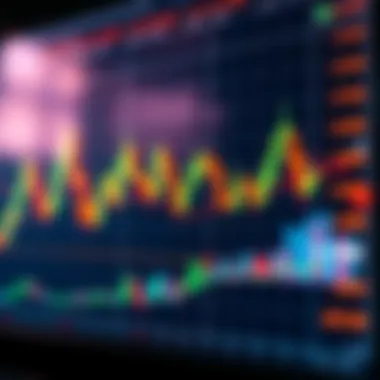

Intro
In the intricate world of stock trading, a candle is more than just a flickering source of light. The candlestick chart is a powerful tool that traders utilize for insights into market dynamics. Though often daunting for beginners, understanding candlestick patterns can significantly enhance one’s ability to make informed decisions.
Candlestick charts translate price movements into a visually engaging format that tells a story of market sentiment over a specific time frame. These charts consist of candlesticks themselves, each representing four key price points: opening price, closing price, highest price, and lowest price. With just a glance at these formations, traders can gauge market sentiment—whether bulls or bears are in control—and predict potential future movements.
Throughout this guide, we will delve into essential concepts surrounding candlesticks, such as how they are constructed, their significance, and the various patterns that arise from them. Besides, we will investigate how these patterns intersect with other technical indicators to mold trading strategies that can confound even seasoned traders.
So grab your charts and let’s unravel the fascinating world of candlestick analysis.
Preamble to Candlestick Charts
Candlestick charts represent one of the most powerful tools in a trader’s arsenal, providing a visual overview of price movements over specific time frames. Understanding these charts is essential for anyone dipping their toes into the world of trading—be it as a novice investor or a seasoned analyst. The allure of candlestick patterns lies in their ability to convey complex data in an intuitive and visually engaging manner, making them accessible for many.
The components of candlestick charts tell a story through price action. Each candlestick reflects the open, high, low, and close prices for a predetermined time span, capturing market sentiment in a single representation. This section of the article will guide you through the fundamentals of candlestick charts, enabling traders to identify patterns that signal future price behavior.
Benefits of Understanding Candlestick Charts:
- Visual Representation: Unlike traditional line charts, candlesticks show a clearer picture of market momentum and volatility.
- Quick Analysis: A trader can glean essential information merely by observing the candlesticks rather than sifting through raw numbers.
- Identification of Trends: Recognizing patterns in candlestick formations can help attract investors to trends, enhancing profitability.
One must also pay attention to context. For instance, a candlestick might appear bullish, yet the overall market trend could be bearish. Hence, understanding the framework in which these candles are set is pivotal for accurate interpretation.
Definition of Candlestick Charts
Candlestick charts are a type of financial chart used to represent price movements in the market. Each "candlestick"—constructed from a rectangular body and two thin wicks—depicts four essential data points: the opening price, closing price, highest price, and lowest price within a specific timespan. The body of the candlestick is colored differently based on whether the asset closed higher than its opening (usually green or white) or lower (often red or black).
A single candlestick can represent different timeframes—anything from minutes to days to months—making them versatile for analysis. Traders will frequently refer to candlesticks as portraying market dynamics over time, which can be instrumental in making investment decisions.
History and Evolution
The origins of candlestick charting can be traced back to Japan in the late 18th century. A rice trader named Munehisa Homma is credited with developing this technique to analyze rice prices in his marketplace. He utilized candlestick formations to better understand market psychology and price behavior, which allowed him to execute more informed trades.
The method lay dormant until it caught the attention of Western traders in the late 20th century, particularly through the work of Steve Nison, who brought the concepts to the mainstream investing community in his book "Japanese Candlestick Charting Techniques." Today, candlestick charts are a cornerstone in technical analysis, used by traders globally on various trading platforms.
Understanding their evolution provides insight into why they remain relevant today: in an era dominated by data, the ability to interpret price action visually taps into the human instinct to categorize and simplify information. As trading methodologies continue to advance, candlestick patterns remain a staple, highlighting their significance within the financial realm.
Components of Candlestick Patterns
When it comes to understanding the intricate dance of the financial markets, candlestick patterns offer a unique window into trader psychology. Each candle tells a story of price movement within a specified time frame, thus diving into the components of these patterns is essential for any serious trader or investor.
Understanding the Body and Wicks
At the heart of every candlestick lies its body, the rectangular part that reflects the difference between the opening and closing prices. A bullish candle, one that closes higher than it opens, will typically be colored white or green, while a bearish candle denotes a falling price, often decorated in red or black. The visual distinction here is crucial; it immediately communicates market sentiment.
But don’t overlook the wicks – those thin lines that extend above and below the body. They are crucial in showcasing the range of price movement. The upper wick shows the highest price reached during the time frame, while the lower wick depicts the lowest price. In short, they demonstrate volatility and give insight into potential reversals.
Why Wicks Matter
- Volatility Indicator: Long wicks indicate traders are uncertain, suggesting potential reversals.
- Market Rejection: A long upper wick can indicate that buyers pushed the price up but sellers stepped in to drive it down.
- Entry Points: Many traders look to wicks for signals to enter or exit trades. For instance, a bearish reversal may be indicated by a long upper wick on an otherwise bullish trend.
Ultimately, understanding the interplay between the body and the wicks can greatly inform trading decisions, guiding investors through the murky waters of the market.
Color Significance
The color of a candlestick is far from insignificant; it carries meaning that can influence market strategies. As previously mentioned, bullish candles are often light-colored while bearish candles take on darker shades. However, the real significance of color comes into play in patterns and sequences.
Color Implications
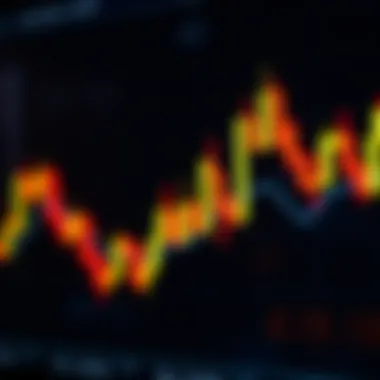
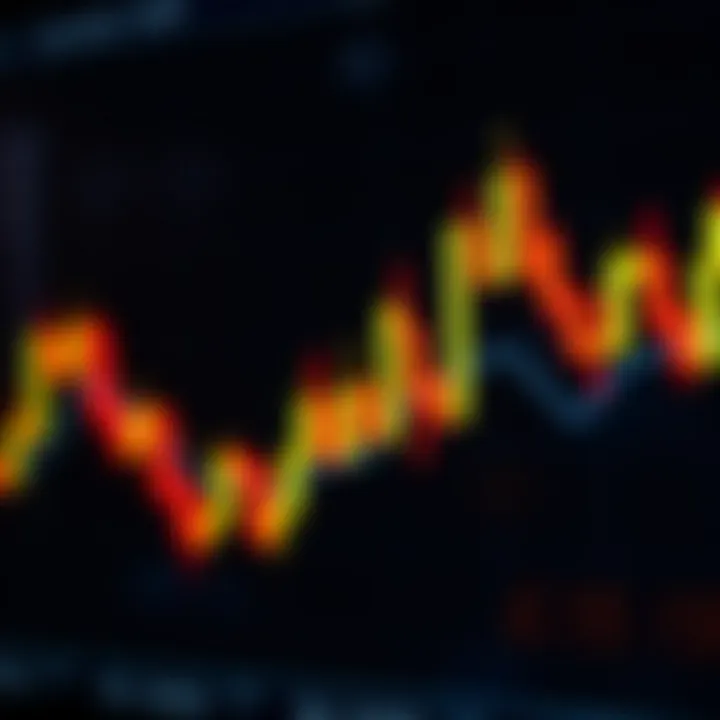
- Bullish Trends: A series of light candles can signify strong upward momentum, indicating steady buying pressure.
- Bearish Trends: Conversely, a sequence of dark candles suggests selling pressure that may be overwhelming.
- Reversals: A shift from colored to uncolored candles or vice versa can signal a potential trend reversal. For instance, a transition from a series of bearish candles to a bullish candle could indicate that buyers are starting to overpower sellers.
- Doji Candles: Not to forget, a doji occurs when the opening and closing prices are nearly identical. Its significance lies in indecision – an important signal that either side lacks strength.
In using color effectively, traders can glean insights into market behavior and sentiment, empowering them to make sharper trading decisions.
Key Insight: The body, wicks, and color of candlesticks form a narrative, guiding traders through the story of the market. Recognizing the subtleties of these components is paramount in enhancing trading strategies.
Time Frames in Candlestick Charts
Understanding time frames is crucial when working with candlestick charts. The time frame you select can dramatically influence both your interpretation of price movements and your overall trading strategy. Different traders may look at different time frames depending on their goals, trading styles, and the asset's volatility. An effective approach takes into consideration both your personal strategy and the nature of the market.
Choosing the Right Time Frame
Selecting the right time frame is not just about picking a number; it can feel like picking a pair of glasses, each offering a different view of the market. Here are some essential factors to consider:
- Trading Style: Day traders often prefer shorter frames like 1-minute or 5-minute charts to seize quick price movements. On the other hand, swing traders might look for shifts over several hours to days, favoring 1-hour or daily charts.
- Market Noise: Shorter time frames tend to be noisier. If you’re not cautious, price spikes can lead you down rabbit holes of false signals. Thus, understanding the environment is key in minimizing distractions and spotting true trends.
- Psychological Comfort: Stick to a time frame that aligns with your risk tolerance. If you tend to second guess during high stress, then perhaps longer time frames, like hourly or daily, might suit you better to give you some breathing room.
Understanding Trends Across Time Frames
Trends don't just exist in isolation; they ripple through various time frames. This interconnectedness makes it vital to analyze multiple frames to develop a nuanced view of the market. Here’s why:
- Confirmation of Trends: If a trend is visible on a daily chart, checking the 4-hour or 1-hour chart can help confirm the trend's strength. A bullish signal on both long and short time frames offers more reliability.
- Divergence of Signals: Occasionally, price action on differing time frames can lead to mixed signals. For instance, a stock might show a bullish trend on the daily chart while revealing a bearish signal on the hourly chart. Spotting such divergences can alert traders to potential trend reversals or corrections.
- Strategic Entry and Exit Points: Combining insights from various time frames can equip traders with better entry and exit points. A trader could spot a bullish candlestick pattern on a 4-hour chart while confirming a strong underlying trend using the daily chart.
"Understanding time frames is like understanding the heartbeat of the market; whenever you change the beat, you change the dance!"
The essence of mastering candlestick charts lies in respecting the different periods in which prices oscillate. Each time frame you choose acts like a different lens, focusing on distinct aspects and trends, helping you to carve out well-informed trading strategies. By choosing wisely, you set a solid foundation for interpreting market movements and improving your decision-making process.
For further insights into trading strategies, consider visiting Investopedia for a broad array of resources that tackle technical analysis in depth. You can also look into academic studies on finance and behavioral aspects through JSTOR.
Key Candlestick Patterns
Understanding key candlestick patterns is crucial for anyone looking to navigate the complexities of stock trading. These patterns offer insights into price movements, trader sentiments, and potential future actions in the market. By recognizing these formations on a candlestick chart, investors can make informed decisions that could lead to profitable trades. Candlestick patterns simplify the interpretation of price action, helping traders spot bullish or bearish trends and determine optimal entry and exit points.
Bullish Patterns
Single Candlestick Patterns
Single candlestick patterns serve as a powerful signal of potential price reversals or continuations. One of the notable characteristics of single candlestick patterns, such as the hammer or the engulfing candle, is their ability to reflect sudden changes in market sentiment. A hammer, for example, typically appears at the bottom of a downtrend and suggests that buyers are beginning to dominate the market, thus hinting at a possible upward price movement.
This simplicity is what makes single candlestick patterns a favored choice among traders; they can be recognized quickly and provide clear signals. However, while they can be beneficial, they often need to be considered within a broader market context to avoid false interpretations. An over-reliance on a single candlestick pattern without corroborating evidence from other market indicators can lead to hasty decisions, emphasizing the need for caution.
Multi-Candle Patterns
Moving to multi-candle patterns, these formations encompass two or more candles, presenting an intricate relationship between price movements over time. Recognized patterns, such as the morning star or the bullish engulfing, signify a stronger conviction among traders. The morning star is particularly notable as it indicates the potential reversal of a downtrend, where a series of candles works together to tell a more complete story than a single candlestick could.
Multi-candle patterns are advantageous because they tend to produce more reliable insights into market behavior. However, they require keen observation to accurately interpret the message conveyed by the collective movements. One downside is their potential complexity; they might confuse novice traders who may misinterpret the nuances. Thus, they’re best suited for those with a bit more experience under their belts.
Bearish Patterns
Reversal Patterns
Reversal patterns serve as a warning sign that the bullish momentum is losing steam. Patterns like the shooting star or the evening star symbolize an impending downtrend. A shooting star, formed after an uptrend, illustrates how buyers have pushed prices up, but sellers have swiftly stepped in, indicating a potential reversal. This characteristic makes reversal patterns an essential aspect of candlestick analysis, alerting traders to possible trend changes.
The strength of reversal patterns lies in their ability to signal market shifts early on. However, traders must exercise caution; false signals can occur, and it’s pivotal to incorporate additional indicators when acting on these patterns to safeguard against misinterpretation.
Continuation Patterns
On the other hand, continuation patterns signal that existing trends are likely to persist. Classic formations like the bullish flag or ascending triangle indicate a temporary pause in price movements before the uptrend resumes. The key characteristic of continuation patterns is the way they consolidate prior trends in a manner that suggests imminent future movements in the same direction.
Such patterns can be particularly favorable for traders looking to capitalize on sustained momentum. However, much like their reversal counterparts, they come with risks; failing to consider overall market conditions and other technical indicators may result in unintended entries.
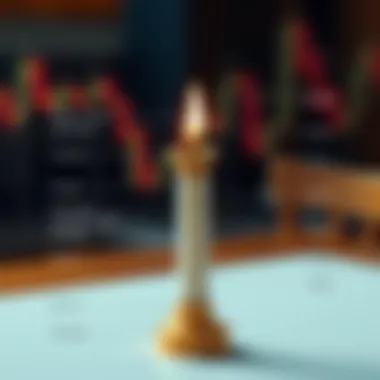
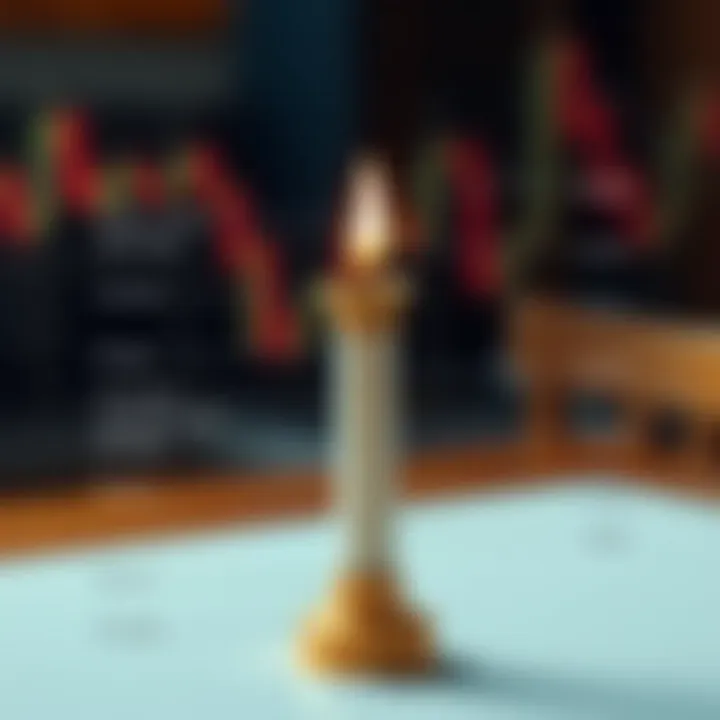
In summary, understanding key candlestick patterns is not just about reading charts but comprehending the market's emotional landscape. A thorough grasp of bullish and bearish patterns, whether single or multi-candle, can significantly enhance a trader’s ability to navigate the market effectively. For further reading on candlestick analysis, consider exploring resources like Investopedia or Wikipedia, which provide additional insights into these powerful trading tools.
Interpreting Candlestick Signals
Understanding how to interpret candlestick signals is crucial for anyone involved in trading or investing. These signals not only reflect market sentiment but also provide insights into potential future movements. By learning to read these signals, traders can better align their strategies with the behaviors of the market, honing in on buy or sell opportunities.
Candlestick patterns can be likened to a story being told through the charts—each candlestick has something to say about market activity over a specified time period. Just as you wouldn't jump to conclusions in a story without reading all the chapters, analyzing these signals requires thorough observation and context.
Analyzing Volume with Candlestick Patterns
One key aspect of interpreting candlestick signals is volume. Volume represents the number of shares or contracts traded within a specific timeframe. When aligned with candlestick patterns, it enhances the validity of the signals being analyzed. For instance, a bullish engulfing pattern is more convincing when accompanied by higher trading volume. This suggests stronger consensus among traders about the price movement, making it less likely to be a false indicator.
Conversely, a pattern occurring with low volume might raise a red flag. It could mean that not many participants believe in the price action, diminishing the pattern's reliability. Thus, volume acts as a critical confirmation tool when interpreting candlestick signals, allowing for more informed decision-making.
Combining Candlestick Patterns with Other Indicators
Candlestick analysis, while powerful on its own, tends to yield even better results when combined with other technical indicators. Understanding how these additional tools function can vastly improve the accuracy of trading strategies.
Moving Averages
Moving averages, one of the simplest yet most effective indicators, smooth out price data over a specific period, enabling traders to identify trends more easily. The beauty of moving averages lies in their ability to filter out noise from random price fluctuations. When a candlestick pattern appears alongside a moving average crossover—like when the short-term moving average crosses above the long-term moving average—it adds weight to the bullish signal. This can provide a clearer picture of the trend's strength and direction.
However, moving averages do have their limitations. The major drawback is that they are lagging indicators. This means they react to price changes after they’ve occurred, which can lead to missed opportunities or delayed responses to market shifts. Therefore, they should be used judiciously in conjunction with other tools.
Relative Strength Index
Another valuable indicator is the Relative Strength Index (RSI), which measures the speed and change of price movements. This oscillator operates on a scale of 0 to 100, indicating overbought or oversold conditions in the market. When traders observe RSI readings above 70, they might interpret it as a sign that the asset is overbought, potentially forecasting a pullback. On the flip side, readings below 30 might indicate oversold conditions, signaling a buying opportunity.
One of the unique characteristics of the RSI is that it often shows divergence from price action. For instance, if prices are rising while the RSI trends downward, this could signal weakness in the current trend. It creates an opportunity for traders to question the sustainability of the price movement and interpret candlestick patterns with greater caution.
While the RSI provides essential insights, it can be misleading during strong trending markets. It may indicate overbought conditions during rallies while the trend continues upward, leading traders to premature conclusions. Thus, like moving averages, it’s most beneficial when used alongside candlestick analysis to confirm or refute the signals seen on the chart.
"Understanding candlestick patterns without considering volume and other indicators is like painting in the dark; you might create something beautiful, but you won’t see the full picture until the lights come on."
Embracing a comprehensive approach that incorporates volume analysis, moving averages, and the Relative Strength Index sets a solid foundation for interpreting candlestick signals. This multifaceted method can substantially enhance a trader’s ability to make informed decisions in the fast-paced world of stock trading.
Common Mistakes in Reading Candlestick Patterns
Understanding candlestick patterns can provide traders a leg up in the stock market. However, it’s all too easy to stumble into common pitfalls that can derail your strategies. This section will highlight two of the most prevalent mistakes: the over-reliance on single patterns and neglecting the broader market context. Learning about these mistakes not only helps in avoiding them but also ensures more sound decision-making.
Over-Reliance on Patterns
One key mistake that many traders make is putting too much faith in the patterns themselves. Candlestick patterns, whether they're bullish engulfing or doji, can sometimes give false signals. The reliance on a single formation can lead to skewed interpretations of the market's direction. For instance, if a trader spots a hammer pattern, they might hastily decide that a reversal is imminent without sufficient evidence to back this decision. This over-confidence can become detrimental.
"The market is a tricky beast. Watching just one candle can lead you astray."
Instead of solely depending on the patterns, consider these aspects for a balanced approach:
- Confirmation from Other Indicators: It’s beneficial to cross-check the candlestick signals with indicators such as moving averages or the Relative Strength Index (RSI).
- Volume Analysis: Look at the trading volume accompanying a pattern. A bullish signal in low volume might signify weakness.
- Long-term Trends: Ensure that the patterns align with the broader market trends. If the overall market is bearish, a bullish pattern might be a false flag.
Neglecting Market Context
Another rookie error is overlooking the broader market context when interpreting candlestick patterns. Every trader knows that the market behaves differently under various conditions, yet many still treat candlestick signals as isolated cases. This mistake can spell disaster for less-experienced traders.
For instance, a bullish reversal pattern might appear after a significant news event, but if the underlying sentiment is overwhelmingly negative, the bullish signal could easily fizzle out. It’s not just about what the candle shows, but also why it’s showing that.
To avoid this pitfall, here are some strategies:


- Keep An Eye on News and Events: Economic reports or geopolitical news can greatly impact market movements. Being aware of them can give you important context.
- Broader Market Sentiment: Utilize sentiment analysis tools to gauge the mood of the market. Understanding if traders are predominantly fearful or greedy can provide valuable insight.
- Sector Analysis: Sometimes certain sectors react differently. For example, in a tech crash, a bullish pattern in a tech stock may not hold the same weight as it would in a stable sector like utilities.
Psychology Behind Candlestick Patterns
Understanding the psychology that drives candlestick patterns is vital for any trader who wants to navigate the turbulent waters of the stock market. Market participants are not just driven by fundamental data; emotions play a pivotal role in their decision-making process. Each candlestick on a chart represents a collection of collective sentiment, showing how traders reacted to price changes within a certain timeframe. By deciphering these patterns, traders can comprehend not only the current market situation but also gauge future movements based on past human behavior.
Market Sentiment and Price Action
Market sentiment refers to the overall feeling or attitude of traders toward a particular stock or market. When looking at candlestick patterns, one might see a series of bullish candles indicating optimism, or conversely, a string of bearish candles signaling concern. This sentiment is pivotal because it sets the tone for price action.
- Bullish Sentiment: In periods where prices are rising, you may observe bullish candlestick formations, where the body is typically filled and long. This suggests that buyers are in control, demonstrating confidence in the upward trajectory. For instance, a strong green candlestick can signify that the bulls have taken charge, reflecting the market's positive outlook.
- Bearish Sentiment: Conversely, when the stock price is declining, patterns of bearish candlesticks with longer bodies and relatively small wicks can indicate that sellers are prevailing. A long, red candle might indicate a significant sell-off, reflecting market uncertainty or negative news.
Understanding market sentiment is not just about observing price action; it's about predicting future action based on group psychology.
Observing candlestick patterns provides insights into this sentiment. For example, a Doji candle—where the opening and closing prices are nearly equal—can signal indecision among traders. This may indicate that a price reversal could be on the horizon if it's situated at a significant support or resistance level. If the subsequent candlestick is a strong move in either direction, it confirms that sentiment has shifted, allowing traders to position themselves accordingly.
Behavioral Finance Insights
Behavioral finance delves into the psychological factors that impact investor decisions. This field explains why market participants often act against their rational self-interest, driven by biases and emotions. Several concepts relate to candlestick patterns:
- Loss Aversion: Traders often feel the pain of a loss more acutely than the joy of a comparable gain. This tendency can lead to panic selling, which is often visible in candlestick formations. For instance, if a stock has been on a steady rise, but suddenly you see a cluster of long red candles, it might indicate that investors are reacting emotionally to a downturn.
- Herd Behavior: The inclination to follow the crowd can distort market reality. When many traders see a bullish pattern and jump in, you may witness a rapid escalation in the stock price, creating what is often labeled as a bubble. Conversely, if a bearish pattern emerges in a market driven by fear, it could result in drastic declines.
- Overconfidence: Many traders fall prey to overestimating their knowledge and abilities, leading to risky decisions. This is sometimes reflected in the volatility of candlesticks. A series of erratic candles may ultimately result from overconfident traders entering and exiting positions without fully considering the market context.
Understanding the interplay of these psychological factors not only informs a trader about the current state of the market, but it also helps in predicting future price actions and trends. As emotional responses often drive market movements, only by recognizing these patterns can one navigate effectively to make informed trading decisions.
As we delve further into the world of candlestick patterns, it becomes clear that the psychology of traders is as critical as the charts themselves. By integrating psychological insights with technical analysis, traders and investors can enhance their strategies and better anticipate market changes.
For further understanding of these concepts, consider visiting resources such as Investopedia, Wikipedia, or Yahoo Finance.
Practical Applications of Candlestick Analysis
Candlestick analysis is not just a technical tool; it’s a lens through which traders can view and interpret market dynamics. Understanding how to apply candlestick patterns in a practical sense can separate a novice trader from a seasoned expert. The real-life implications of this approach are substantial; by integrating these patterns into trading strategies, investors can enhance their decision-making process and better predict market movements.
Developing a Trading Strategy
Crafting a successful trading strategy using candlestick patterns requires in-depth analysis and strategic thinking. Traders need to focus on several key aspects in this development phase:
- Identifying Patterns: Recognizing various candlestick formations, such as the doji, hammer, or engulfing patterns, is pivotal. Each pattern tells a story about market sentiment and potential price action.
- Setting Entry and Exit Points: After pinpointing patterns, a trader should articulate rules for entry and exit that align with those signals. For instance, a bullish engulfing pattern might suggest a buy, while a bearish doji may indicate a sell.
- Risk vs. Reward Assessment: Understanding potential gains against potential losses is crucial. This involves determining how much capital one is willing to risk per trade.
- Backtesting Strategies: Before diving headfirst, testing the strategy in a simulated environment allows traders to evaluate its effectiveness without financial risks involved.
As you begin to develop your strategies, remember that consistency is key. The market's ebb and flow can be unpredictable, but having a solid plan can significantly smooth out the bumps.
Risk Management Techniques
Managing risk is as essential as recognizing patterns on a candlestick chart. The following techniques can provide a safety net for traders:
- Stop-Loss Orders: Implementing stop-loss orders helps protect your capital. If the market moves against a trader’s position, a stop-loss automatically triggers a sale to limit losses.
- Position Sizing: This involves calculating the amount of capital to risk on each trade, ensuring that no single loss can significantly impact the overall account. A common method is to risk a small percentage—often around 1%-2%—of the total trading capital.
- Diversification: Spreading investments across different instruments can buffer against unexpected market movements. For instance, mixing stocks, commodities, or forex can mitigate risks associated with any one asset class.
- Continuous Learning: The market is ever-changing. Staying updated on trends, economic factors, and market sentiment can provide traders a competitive edge.
"To be successful in trading, one must not only know the game but also strategize how to navigate through it with minimal risk."
Ultimately, candlestick analysis—when applied wisely—can enhance a trader's ability to read the market. The combination of a robust trading strategy and effective risk management techniques creates a foundation for successful trading in volatile markets. Familiarizing oneself with these principles can lead to improved performance and better decision-making, regardless of market conditions.
Culmination
In the realm of stock trading, being adept at reading candlestick patterns can be a game changer. This article has laid out a foundation for understanding not only the mechanics of candlestick charts but also the psychology that drives market behavior. The ability to interpret these patterns equips traders and investors with a more nuanced tool for analyzing price action.
Summary of Key Takeaways
- Understanding Candlestick Basics: Recognizing the components of candlesticks—the body and wicks—is fundamental. Each candlestick represents a specific period's open, high, low, and close, serving as a storytelling device for price movements.
- Pattern Recognition: Candlestick patterns can be catalysts for significant trading decisions. Familiarity with bullish and bearish patterns, whether they’re single or multi-candle formations, can guide investors in predicting market moves.
- Context is Key: Relying solely on candlestick patterns without considering the broader market context can lead to misinterpretations. Trends, economic indicators, and volume should always be weighed alongside these patterns.
- Integration with Other Indicators: A further enhancement comes from combining candlestick analysis with other indicators like Moving Averages and the Relative Strength Index. This multi-faceted approach not only validates signals but also adds a layer of security to the trading strategy.
- Psychology of the Market: Understanding market sentiment is crucial. The psychology behind candlestick formation often reflects the collective emotions of traders, making it an indicators for potential reversals and continuations.
- Trading Strategy Development: By harnessing the insights gleaned from candlestick patterns, traders can create well-defined strategies that account for risk management, optimizing the chances of success in volatile markets.
Future Trends in Candlestick Analysis
Looking ahead, the evolution of technology and data analytics is likely to reshape the way traders use candlestick charts. Advanced algorithms and machine learning are beginning to analyze patterns beyond human capabilities. This development may yield even more precise predictions about market movements. As candlestick analysis becomes increasingly integrated with artificial intelligence, traders will not only identify patterns but also understand their probable outcomes based on vast data sets.
Additionally, the rise of cryptocurrency trading has introduced new candlestick patterns, significant price volatility, and unique market sentiment which diverges from traditional stock markets. This convergence of technologies and trends promises to create fresh methodologies for interpreting candlesticks.
Ultimately, staying ahead requires a proactive approach toward learning and adapting. Whether one is a seasoned trader or just starting out, the ongoing exploration of candlestick patterns will remain a vital aspect of market analysis.















